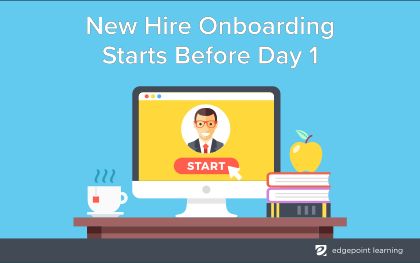How to Train Your New Employees Effectively
Corey Bleich
🍿 7 min. read
You wouldn’t hand a new high school graduate the keys to a Tesla and let them go, but this is an exaggerated equivalent of some company new hire training programs. Learning how to train new employees effectively is the cornerstone of success for any company. This post is your guide to better and more effective new hire training. Keep reading to learn more.
Why is a new hire training program necessary?
It’s a common mistake that even the most successful businesses make: not formally training new employees.
Some companies believe that new employees will learn as they go, on the job, foregoing a new hire training program. While there is plenty of space for on-the-job training, knowing how to train new employees effectively means happier employees and better retention rates.
Consider that 20% of workers in the U.S leave their job within 45 days of hire (with that number skyrocketing to 50% in the retail sector).
According to some estimates, the cost of replacing employees who make $30,000 a year or less is 16% of their annual salary. But for higher-level employees, those making over $75,000, that number can be 20% of their annual salary or higher. So, once you find the best employees for your team, you want to keep them there. And, following some best practices for employee onboarding is one of the most effective ways to do so.
TinyPulse reports that:
- 91% of employees stick around for at least a year when organizations have efficient onboarding processes
- 69% of them stick around for at least three years when companies have well-structured onboarding programs

Now imagine that 91% of your employees stay for at least a year and 69% are still going strong after three years. What does that mean for your bottom line? Your company culture?
How to train new employees effectively
Developing a solid new hire training program is an important management skill. More than just showing new employees where the coffee maker is and how to get their parking permit, training new employees procedures helps employees settle into the rhythm of the company to focus on the most important thing: their job.
While your exact onboarding tasks may differ, these best practices for employee onboarding help you get your employees up-to-speed, whether they’re hourly, C-suite, or anywhere in between. And, they’re just as useful for in-office and remote employees. This is how to put together your new hire training program:
- Establish your new employee procedures, beforehand
- Ensure that all managers use a new hire training checklist
- Start onboarding before day one
- Include onboarding best practices into your procedures
- Train for culture, not just topics
- Build in regular reviews and adjustments to your training program
Let's look at each of these in more detail.
1. Establish your new employee procedures
Before you begin developing a new hire training program, you need to know where you are going. If your company has never identified exactly what each new employee should know, now’s the time to do it.
Putting together new employee procedures helps you to articulate the what, why, when, and how to train new employees effectively. There are five easy steps to this process.
- Identify tasks or procedures employees need to know and break these into steps: Make these tasks and steps as concrete as possible, and have another person who isn't in the role check for clarity.
- Identify the best person to complete the training: Not everyone can train every employee for every skill. Choose the best person for the job.
- Allocate resources: supplies and time: Training new hires is essential. Providing adequate tools and time to learn new procedures and practices (or not!) can make or break your new hire training program. You simply can't expect existing employees to fit training into an already-packed schedule.
- Train: This one word encompasses a range of activities, from online training to microlearning to hands-on practice. Identify the best way to deliver the information for the best chance of success.
- Check for understanding: It’s not enough to just offer the information and hope it sticks. Check employee understanding after training by tailoring employee assignments to the training they received. This helps you to know if employees feel confident in what they have learned or if they need more information.
2. Ensure that all managers use a new hire training checklist
It’s easy to forget where each employee is in the onboarding process. Creating a new employee checklist can help.
This new hire checklist can include:
- Sending a welcome email with first-day practical things like parking and dress code (as we'll discuss next)
- Making sure office space is cleared, stocked, and ready
- Pairing the new employee with a mentor
- Developing an individualized training plan
- Identifying priority topics employee needs training on
- Planning check-in meetings to help new employees feel supported
Checklists make life easier to manage, and a new employee training checklist is no different. The best employee onboarding checklists start before an employee walks in on their first day and can continue for up to six month or a year after they start. Your team may already have a checklist in place, or you can find inspiration in some online employee onboarding checklist templates from:
Your team may already have a checklist in place, or you can find inspiration in some online employee onboarding checklist templates from SmartSheet or Process Street.

3. Start onboarding before day one
Think about your first new day at your job. You were likely nervous—unsure of where to park, when to show up, how to dress, where to eat, or who to talk to.
According to the Aberdeen Group, 83% of the highest-performing organizations began onboarding before the new hire’s first day. Instead of letting new hires flounder on that first morning, send an email before they even show up. Consider including:
- Start-time and location
- Instructions for parking
- A quick overview of what you’ll cover that first day
- What will be ready for them, such as laptops or headphones
- The supervisor’s direct line
- Office culture and dress code
- Links to nearby coffee or lunch places
- Any scheduled meals, meetings, training, or orientations
Make it an easy experience right from the start and you’ll reduce a lot of the frustration new hires experience.
4. Include onboarding best practices into your procedures
Successful companies are successful because of their employees. And employees are successful because their smart managers understand and utilize best practices for employee onboarding. Here's what makes for more effective onboarding.
-
Create a memorable first day that is tailored to what the new employee needs: If your employee is new to the area, make sure they meet the whole team. If they have been in the area for a while but are new to your industry, show them what they are working towards. Taking the time to learn who they are during the interview process can help you to structure a great first day experience.
-
Use varied learning methods suited to the topic at hand: Don’t use a one-size-fits-all approach to training. If your new employees just need up-to-date information on regulations at a job site, use geofencing instead of a full-day training in a conference room. Working through a project and need to share the procedure for the next step? Microlearning is a good go-to strategy.
-
Allow ample time for questions and dialogue: Allowing space and time for questions and concerns is arguably the most important part of the onboarding process. Employees need to know they can get more information if they need it. Make them feel comfortable asking questions by building time into the process.
Find our full step-by-step guide to onboarding here.
5. Train for culture, not just topics
Company culture (think Google’s nap pods and their plethora of freebies from food to massage) can vary wildly. Train for your company’s culture, not just the practical information.
Does your company pride itself on its environmental conservation? Highlight that and show how that works in the workday. Are you known for your ability to work with challenging customers and situations? Demonstrate the problem-solving and customer service skills that are important. One of the most effective ways to communicate this is with a short video directly from your CEO.
Whatever your company’s culture, sharing it is an important part of any new hire training program.
6. Build in regular reviews and adjustments to your training program
Finally, one of the best practices for employee onboarding is to show a continued commitment to their growth. For many employees, they won’t really settle into a new job until six months or more have passed. Many employees won’t feel comfortable coming to you or their supervisor to ask questions. Because of this, be highly available for those six months, scheduling monthly time specifically for in-person check-ins, emailing the employees weekly about any questions they may have, and providing them with any resources they need.
Consider setting up meetings at the end of the first week and month, then again at three months, six months, and twelve months. This regular check-in should not be punitive. The goal here is a happy, supported, productive employee.
Further, unless you review your employees and their work, you won’t know how effective your training program is. Make regular reviews a part of your company’s culture, and adjust your training as needed. Learn more about tracking employee training here.
Learn more about new hire training
Learning how to train new employees effectively can be a daunting task, especially when your company is embarking on a new hire training program. No matter your industry or the size of your workforce, there is help. Our other eLearning posts cover a wide variety of topics for you to learn more, including:
- The Top 10 Types Of Employee Training
- How To Get Your Employees Excited About Training
- How To Run A Training Needs Analysis For Your Workforce
- Where Small Businesses Should Start With eLearning
If you need additional guidance, our team of instructional design experts at EdgePoint Learning can help. We can evaluate your existing programs and develop a plan from there. We offer a number of options to support your employee training goals, including:
- Consulting: We help you analyze your existing resources and develop your course-specific or program-wide learning strategy
- Custom development: From design and development to final roll-out, we create courses made for your company and employees
- Co-development: Our team works as an extension of your company, providing the skills or extra set of hands you need to complete projects
Better new hire training starts here. If you want to learn more about your employee training options, get in touch with EdgePoint Learning today. Want to see our work in action? Find all of our demos here.
